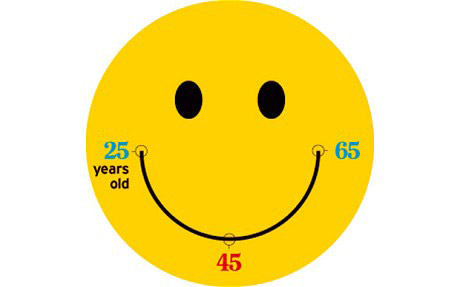|
 Happiness follows a U-shaped curve during a person's lifetime, according to research showing that middle-aged people are the unhappiest. |
|
Happiness follows a U-shaped curve during a person's lifetime, according to research showing that middle-aged people are the unhappiest. Satisfaction with life starts to drop as early as a person's late 20s and does not begin to recover until well past 50, says Bert van Landeghem, an economist at Maastricht University in Belgium. While young adults are carefree and full of hope for the future and the over-50s have come to terms with the trials of life, the research indicates that those in the middle feel weighed down by the demands on them. The study found "a substantial dip in happiness during the middle of people's lives is the equivalent to becoming unemployed or losing a family member". The conclusions come in a study of how people perceive their wellbeing. Mr van Landeghem, who is 29, will present his research at the Royal Economic Society annual conference at Royal Holloway, the University of London, this week. While he said happiness did return with age, he warned that older people did not actually recapture the spirit of their youth. They simply learnt to be satisfied with their lot. "A U-shaped happiness curve does not necessarily imply that a 65 year-old prefers his own life to the life of a 25 year-old," he said. "Both the 25 year-old and 65 year-old might agree that it is nicer to be 25 than to be 65. But the 65 year-old might nevertheless be more satisfied, as he has learned to be satisfied with what he has." Studies around the world have shown that happiness tends to dip in midlife, he said, and that this was not just a phenomenon confined to the Western world. Last month, Lewis Wolpert, emeritus professor of biology at University College London, said happiness could peak as late as 80. In a book called You're Looking Very Well, Prof Wolpert said most people were "averagely happy" in their teens and 20s, but this declined until early middle age as they attempted to support a family and career. He added: "From the mid-40s, people tend to become ever more cheerful and optimistic, perhaps reaching a maximum in their late 70s or 80s." An easing of the responsibilities of middle age, maturity and an increased focus on the things we enjoy contributed to the trend, he said. (Read by Renee Haines. Renee Haines is a journalist at the China Daily Website.) (Agencies) |
研究顯示,人一生中的快樂感是條U曲線,中年人是最不快樂的。 比利時馬斯特里赫特大學的經濟學家伯特?凡?蘭德亨說,一個人對生活的滿意度在接近三十歲時會開始不斷下降,一直到五十好幾才會有所回升。 研究表明,青年人無憂無慮,對未來充滿希望,五十多歲的人已經適應了生活的種種考驗,而中年人則被眾多煩惱困擾。 研究發現,“人到中年,快樂感明顯降低,這種心態轉變相當于失業或痛失家人。” 該研究調查了人們對自身幸福的感知狀況,從而得出了這一結論。 現年29歲的凡?蘭德亨先生本周將在倫敦大學皇家霍洛威學院舉行的皇家經濟學會年會上提交他的研究報告。 盡管凡?蘭德亨說快樂感隨著年齡增長還會回升,但他警告說老年人并不會重獲年輕時的朝氣。他們只是懂得知足常樂罷了。 他說:“快樂U型曲線并不意味著65歲的老人喜歡自己的生活勝過25歲年輕人的生活。不論是25歲的年輕人,還是65歲的老人,都會認為25歲比65歲要好。但是65歲的人會更滿足,因為他已經學會知足常樂。 他說,世界范圍內的研究都顯示,快樂感在中年時會下降,這并不是只有西方國家才出現的現象。 倫敦大學學院生物學的名譽教授路易斯?沃爾伯特上個月稱,快樂感會在80歲高齡時達到頂峰。在一本題為《你看起來很棒》的書中,沃爾伯特教授說,大部分人在青少年和20多歲時都覺得“還算快樂”,但是當他們開始為家庭和事業奮斗時,快樂感就不斷下降,直到進入中年后才有所回升。 他還說:“從四十五歲左右開始,人們會變得快樂、樂觀起來,這種樂觀心態可能會在七八十歲時達到頂峰。” 他說,人到中年,肩上的責任減輕了,人更成熟,而且會把注意力更多地放在讓自己心情愉悅的事物上,這些都有助于快樂感的提升。 相關閱讀 (中國日報網英語點津 陳丹妮 編輯: 馮明惠) |
|
Vocabulary: come to terms with: 遷就順從;接受(令人不快的事物);適應(困難的處境) weigh somebody down: 使煩惱;使焦慮;使憂心忡忡 lot: a person's luck or situation in life(命運;生活狀況) emeritus professor: 名譽教授 |